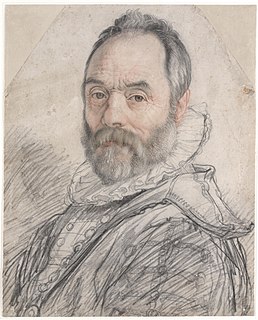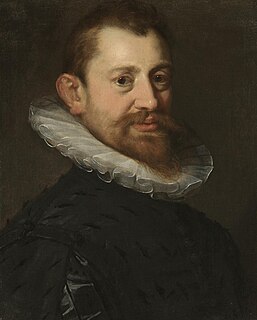
Giambologna — — was a Flemish sculptor based in Italy, celebrated for his marble and bronze statuary in a late Renaissance or Mannerist style.

Antonio del Pollaiuolo, also known as Antonio di Jacopo Pollaiuolo or Antonio Pollaiuolo, was an Italian painter, sculptor, engraver and goldsmith during the Italian Renaissance.

Sir Anthony Alfred Caro was an English abstract sculptor whose work is characterised by assemblages of metal using 'found' industrial objects. His style was of the modernist school, having worked with Henry Moore early in his career. He was lauded as the greatest British sculptor of his generation.

Adriaen de Vries (c.1556–1626) was a Northern Mannerist sculptor born in the Netherlands but working in Central Europe, whose international style crossed the threshold to the Baroque; he excelled in refined modelling and bronze casting and in the manipulation of patina and became the most famous European sculptor of his generation. He also excelled in draughtsmanship.

Giuliano Finelli (1601–1653) was an Italian Baroque sculptor who emerged from the workshop of Bernini.

Francesco Laurana, also known as Francesco de la Vrana was a Dalmatian sculptor and medallist. He is considered both a Croatian and an Italian sculptor. Though born in the territory of the Republic of Venice, he spent his mature career at the other end of Italy, moving between Naples and Sicily, and Urbino, and finally in southern France, where he died.
Events from the year 1573 in art.

Baroque sculpture is the sculpture associated with the Baroque style of the period between the early 17th and mid 18th centuries. In Baroque sculpture, groups of figures assumed new importance, and there was a dynamic movement and energy of human forms—they spiralled around an empty central vortex, or reached outwards into the surrounding space. Baroque sculpture often had multiple ideal viewing angles, and reflected a general continuation of the Renaissance move away from the relief to sculpture created in the round, and designed to be placed in the middle of a large space—elaborate fountains such as Bernini's Fontana dei Quattro Fiumi, or those in the Gardens of Versailles were a Baroque speciality. The Baroque style was perfectly suited to sculpture, with Gian Lorenzo Bernini the dominating figure of the age in works such as The Ecstasy of St Theresa (1647–1652). Much Baroque sculpture added extra-sculptural elements, for example, concealed lighting, or water fountains, or fused sculpture and architecture to create a transformative experience for the viewer. Artists saw themselves as in the classical tradition, but admired Hellenistic and later Roman sculpture, rather than that of the more "Classical" periods as they are seen today.

Nicolas Régnier (1591–1667), known in Italy as Niccolò Renieri, was a painter, art dealer and art collector from the County of Hainaut, a French-speaking part of the Spanish Netherlands. He is often referred to as a Flemish artist because this term was often used to designate people from the Spanish Netherlands. After training in Antwerp, he was active in Italy where he was part of the international Caravaggesque movement. His subjects include genre scenes with card players, fortune tellers, soldiers and concerts, religious scenes, saints, mythological and allegorical scenes, and portraits. He also painted a few scenes with carnivals.
Events from the year 1626 in art.
Events from the year 1686 in art.
Sebastiani may refer to any of the following people:
Events from the year 1552 in art.

Nicholas Stone was an English sculptor and architect. In 1619 he was appointed master-mason to James I, and in 1626 to Charles I.

Giuseppe Giorgetti was an Italian sculptor in Rome who worked first under his older brother Antonio Giorgetti and took over his workshop after Antonio died in late 1669. He then also became the principal sculptor for the Barberini family for whom he undertook some restoration of ancient sculptures, most importantly of the Barberini Faun in 1679, carried out together with Lorenzo Ottoni.
Antonio Calcagni is an Italian sculptor of the Renaissance period.
Girolamo Lombardo, also Girolamo Lombardi, (1506-1590) was an Italian sculptor.

Tiburzio Vergelli (1551-1609) was an Italian sculptor and founder.

Sebastián Ducete was a Spanish sculptor. He was born to the sculptor Pedro Ducete Díez in Toro, Zamora in whose workshop Sebastián collected first experiences. From 1591 on he was trained by the sculptor Juan Sanz de Torrecilla from Palencia. From 1595 to 1598 he worked in one workshop with his uncle Juan Ducete the Younger.
Luigi Bernini was an Italian engineer, architect and sculptor.












